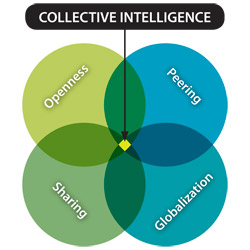Is Collective Intelligence the New Age Norm?

Technology sure has changed. Consider the birthday card that plays “Happy Birthday” when it is opened. After a few days, the recipient casually tosses it into the trash—throwing away more computer power than existed in the entire world before 1950.
“The rate of technological diffusion and the pace at which technology is altering how and with whom we connect is astounding,” states John Seely Brown, author of Growing Up Digital. “Although not at the same pace, theoretical views of learning and teaching are also changing. Whereas much of the initial e-learning simply patterned old models of teaching and learning, the new technological possibilities and realities encourage us to think differently about what is meant by education.”
What seems to be happening now is another transformation, where in a knowledge economy, both knowledge and learning are viewed differently, with a trend toward systems that support people as learners and teachers. (Each participant is both a learner and a teacher.)
Collective intelligence (CI) is a new platform for learning that has changed the way individuals learn today. Collective intelligence emphasizes the social aspects of learning. It is a meeting of minds and collaboration of knowledge, a shared or group brainpower that comes from both the competition and/or collaboration of several individuals. Participants may have different motivations for participating, yet this collaboration validates Stephen Covey’s claim that “all of us are smarter than any one of us.”
According to Wikipedia, CI pioneer George Pór defined the phenomenon as “the capacity of human communities to evolve towards higher order complexity and harmony, through such innovation mechanisms as differentiation and integration, competition and collaboration.” This involves “achieving a single focus of attention and standard of metrics which provide an appropriate threshold of action.”
Collective intelligence refers to a process by which large numbers of people can simultaneously converge upon the same point(s) of knowledge, while achieving enhanced intellectual performance. It can also be defined as a form of networking that has enabled interactivity; thus, users are able to generate their own content. More and more sources (CNN, MSN, etc.) are getting information from user-created and conceptualized content such as blogs, social media and web-based forums.
Collective intelligence is the learner-generated framework in which a group of users collaboratively co-design to create their own context. In this sense, the learner-generated perspective represents an ad hoc community that facilitates the coordination of collective action in a network of trust. The term learner-generated context, says Wikipedia, “originated in the suggestion that an educational context might be described as a learner-centric ecology of resources, and that a learner-generated context is one in which a group of users collaboratively marshal available resources to create an ecology that meets their needs.”
 According to Don Tapscott and Anthony Williams, collective intelligence possesses the following four principles:
According to Don Tapscott and Anthony Williams, collective intelligence possesses the following four principles:
- Openness. Historically, companies were cautious about sharing information to retain their competitive edge. But over time, companies and individuals began to see the benefits of relaxing their grip over resources and began to reap the rewards of collaboration.
- Peering. This is the ability to create products, information and technology across the organization. The results achieved are for the improvement of a product or service. “Peering succeeds,” say Tapscott and Williams, “because it leverages self-organization—a style of production that works more effectively than hierarchical management for certain tasks.”
- Sharing. More companies have started to share with limitations by retaining control over such things as critical patent rights. Companies discovered that by limiting all their intellectual property, they were closing the door on certain opportunities. Allowing a controlled amount of collaboration means that companies can increase market share and turn out products at an accelerated rate.
- Acting globally has become more commonplace because of the strides in communication technologies. Since the inception of the Internet, people are able to communicate across borders, which was the goal of its developer, Tim Berners-Lee. By making international contacts, individuals and companies are establishing global firms and providing worldwide customer service. This allows those companies to gain access to new markets, ideas and technologies.
One of the best-known CI projects has to do with politics and political parties. President Obama launched an online campaign that changed the face of the country by a groundswell of constituents who responded to bad press or rumors instantaneously through websites, blogs and social networking. His campaign was so collaborative that it crossed party lines. A local example of that is former Republican Congressman Ray LaHood, who is now transportation secretary in a Democratic administration.
Terry Flew, author of New Media, cites the Internet as the best example of a learner-generated context in which groups of users pooling their knowledge results in a shared intelligence space. “As the Internet has developed,” says Flew, “so has the concept of collective intelligence as a shared public forum. The global accessibility and availability of the Internet has allowed more people than ever to contribute their ideas and to access these collaborative intelligence spaces.”
Collective intelligence is a new learning format which is revolutionizing the way individuals learn personally and professionally. It promotes learning of the people, by the people and for the people. It has also enhanced and possibly changed the face of the political and business scene by the use of social networking and collaborative communication. Try this new form of learning and experience the development of collaborative solutions as both a student and teacher, while developing ownership of the content. It is an opportunity that should not be missed. iBi
Susan Warren, MBA, is retired from the United States Postal Service and owns SKW Consulting. She is the immediate past president of the Heart of Illinois chapter of ASTD. Tammy Finch is owner of Web Tech Services, Inc. and vice president of technology for the Heart of Illinois chapter of ASTD.

